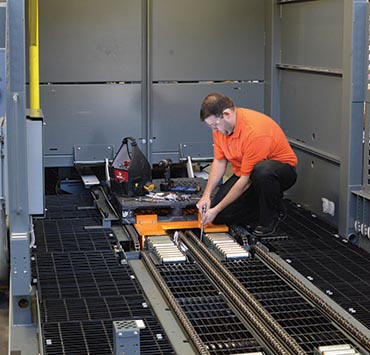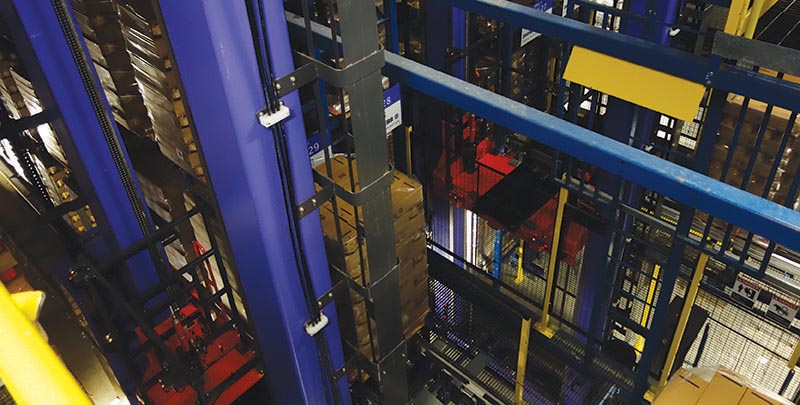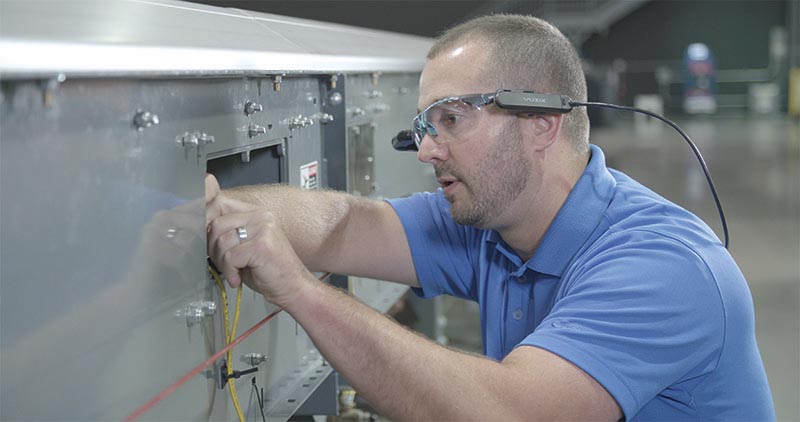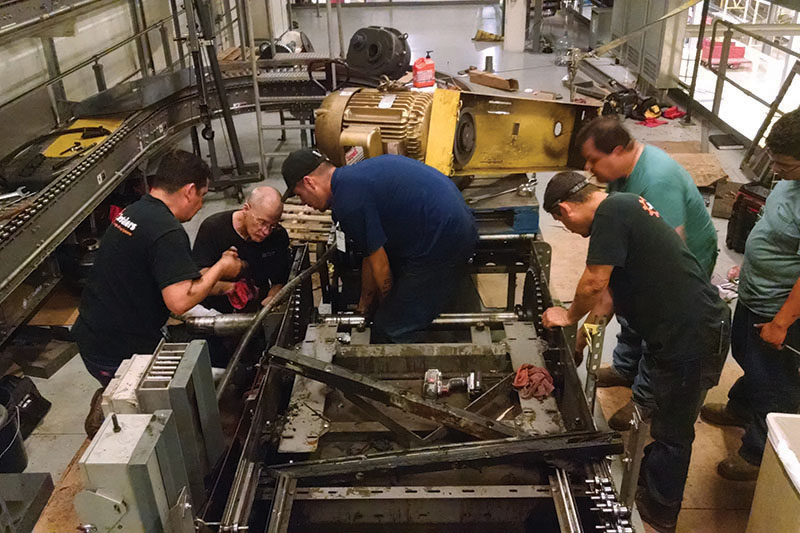Making the Maintenance Shift from Conventional to Automated Systems
The two are fundamentally different worlds that require quite different and diverse training, skills and spare parts inventory to be successful. There are no shortcuts to this transition.
Change is never easy. And that can be an understatement when a facility’s maintenance team is making the shift from servicing conventional materials handling equipment to automation. You may even have some scars to back up that statement.
If you haven’t gone through this rite of passage, however, don’t misinterpret what you just read. The change is not insurmountable. It is not guaranteed to result in big problems for an extended period of time. But in talking to the experts, you need a plan to make the transition as graceful as possible.
That plan depends on the scope of the automation. For instance, Conveyco Technologies’ president Ray Cocozza recommends a nine-step plan that starts during the earliest planning stages of a greenfield automated facility. For those adding automation to an existing predominantly conventional warehouse, Daifuku Wynright’s senior director John Leonard recommends a three- to six-month program prior to startup to reorient the maintenance team.
Regardless of the scope, automation requires “intense, dedicated training. Just shadowing is not enough. You don’t just find competency. You have to develop it,” says Joe Carelli, vice president of lifecycle support services at Honeywell Intelligrated.
Fortunately, no one has to go it alone. System suppliers are strong resources that can help initially and for longer term, explains Dave Beres, director of field services for warehouse automation at Opex.
Just as important, relying on suppliers should not be seen as an internal maintenance shortcoming. Suppliers are experts at maintaining these systems and already have the skilled techs on staff. “We know what specific skills are needed to work on each piece of equipment and have trained our staff accordingly,” says Todd Sermersheim, vice president of customer service operations at Dematic.
And then, you must manage spare parts. This will get your attention quickly.
The experts agree you will have an eight- to 10-fold increase in spare parts inventory in stock. Yes, automated systems are that much more complex. Furthermore, that inventory will require different handling than parts for conventional systems.
Now that you’re running down this path, here’s how to be most successful in the transition.
Getting started
Quite frankly, maintenance, especially of automated systems, is increasingly important to a company’s overall success, explains Jeff Hedges, president of Opex Warehouse Automation. “As planning and budgeting become more difficult, equipment up time and efficiency are ever more critical to successful operations,” he explains. And, that is true in spades for automated systems.
It’s worth underscoring that automated equipment is not just a more complicated form of conventional equipment. The two types are fundamentally different.
“The approach to automation maintenance requires different thinking,” says Beres. “You are going from a mature, highly stable, low-tech environment to one that is definitely high tech and requires special care and training,” he adds.
 So here’s the short course for making the transition from conventional to automated maintenance programs. Plan early. Budget early. Train early. Accept help early.
So here’s the short course for making the transition from conventional to automated maintenance programs. Plan early. Budget early. Train early. Accept help early.
To that end, Cocozza’s nine-step plan actually starts with setting a spare parts and team budget as the business case for the facility that is being built. It continues through all stages including pre-install of the system and installation. At the time of the latter, he recommends the maintenance team begin familiarizing itself with the equipment they will soon work on.
The team should participate in troubleshooting exercises during system testing and work closely with the supplier on safety and operational training. By go-live, you have a team in place and are functioning closely with supplier personnel. Daily operations require regular audits by the supplier to ensure the automation is functioning as intended.
Cocozza also offers three signs that the shift will be unsuccessful regardless of any plan. He starts with limited executive willingness to commit the necessary resources for success. A second is too much volatility in the company’s business model, which is why some companies outsource maintenance. And the third, and perhaps most important, is lack of commitment to a structured change management process.
Training the team
With that in mind, take a close look at the team itself.
“Central to the process is the team members’ skill levels beyond mechanical, especially electrical and software systems. After all, conventional and automated systems have quite different components and levels of complexity,” explains Leonard.
Beres points out that conventional systems are 90% mechanical, almost Lego-like. Fast forward to automation with its advanced control systems and software change, and that profile changes quite considerably. Furthermore, that shift has significant impact on two factors directly affecting maintenance team success.
The first factor is the ability of techs to maintain the system. Special training and close communication with suppliers are essential. Software and controls skills are quite different than other standard mechanical and electrical tech skills. Meanwhile, suppliers are responsible to deliver software that on-site techs can install and update as needed. No substitute for close communication works here.
Just as on-site techs don’t build the equipment, they don’t build the software. But they do have to be able to efficiently maintain both.
The second factor, which is often a new world for techs, is data. Rather than working to a pre-set schedule, automation maintenance is much more data dependent, explains Carelli.
He says a common question is “do you expect me to monitor data in virtual and real control rooms? And, the answer is yes. Techs need to use the data to run the equipment and building more efficiently. They need to use the data to make maintenance decisions on the fly,” he adds.
According to Don Shoemaker, vice president of engineering and consulting at Synovos, “automation maintenance requires a shift from primarily relying on the knowledge of the tech to the data. That can be a tough transition for some.”
Or as Hedges says, there’s a lot riding on uptime. A strong sense of urgency is needed to stay up and running. And data is part of that automation maintenance toolkit.
All of this puts a premium on key attributes of a successful tech—problem solving, can-do attitude and curiosity, says Sermersheim. Carelli adds work ethic and discipline to that list. Beres likes character and competency. You can’t go wrong with any of them.
This is a good point to discuss the potential role of suppliers and their maintenance teams. As was said earlier, there is no dishonor in opting for contract maintenance with automated systems. In fact, it can be the more prudent path given the company’s expectations and the team’s familiarity with automation.
“Automated systems are highly reliable but must be maintained to a high level to attain that level of reliability,” explains Leonard. Suppliers are often in a better position to deliver such maintenance, at least initially.

It is not uncommon to opt for contract maintenance for the first year of operation. Others rely on it for another year or two. Along the way, the existing tech team can be trained to operate on its own in the future.
Clearly, you can manage this transition plenty of different ways. Once the handoff is completed, Leonard recommends the supplier be brought in to audit the system every six to 12 months to ensure sufficient maintenance levels to meet reliability expectations.
The spare parts equation
But, there’s still the matter of spare parts. Quite frankly, there is a world of difference between spare parts for conventional and automated systems.
Conventional parts are characterized by standard designs, low cost and easy availability, says Beres. Automated parts, he adds, do not have common design, are often unique to a supplier and sometimes require long lead times to acquire.
“With spares for automated systems, you have to mitigate the risk of the unavailability of parts for days or even weeks,” says Beres. That means always having on hand the right spares in dedicated parts cribs, says Sean Cummings, director of e-commerce at Daifuku Wynright.
Typically, this results in much larger spare parts inventories. Cocozza of Conveyco says a small system might need a $30,000 or $40,000 inventory. A large system can easily be 10 times that.
The high value and quantity of automation spares also changes how they are stored, says Carelli. Not only is adequate space needed but special conditions such as climate control might be required. Additional security is not uncommon.
But storage doesn’t stop with space. It also includes systems to track parts.
Some suppliers offer proprietary tracking software, explain Cummings and Carelli. In addition to tracking parts, some have pre-loaded maintenance tasks paired up with required spares. Availability of spares data on tablets is common.

In addition, some suppliers offer extensive programs for lifecycle management of spares.
Another approach is computerized maintenance management systems (CMMS), says Roger Olle of Daifuku Wynright. He calls CMMS the backbone of a well-run maintenance department.
Basic capabilities include ordering/reordering spares and managing them on site. In addition, CMMS tracks maintenance tasks, pairs them with spares and automatically generates work tickets. The idea, Olle explains, is to take routine admin work away from techs, ensure they do not overlook key tasks and keep them focused on their maintenance work to maximize uptime.
In fact, Shoemaker sees these systems as critical to streamlining parts availability. That allows techs to get to their work more quickly and spend more time on maintenance activities.
As you can see, it is no small task to gear up for maintaining automated materials handling equipment and systems. But as many have already proven, it is doable with huge upside benefits. The trick is to manage the process and not think it’s only a little different than maintaining conventional equipment.
Companies mentioned in this article:
Conveyco Technologies
Daifuku Wynright
Dematic
Honeywell Intelligrated
Opex
Synovos













